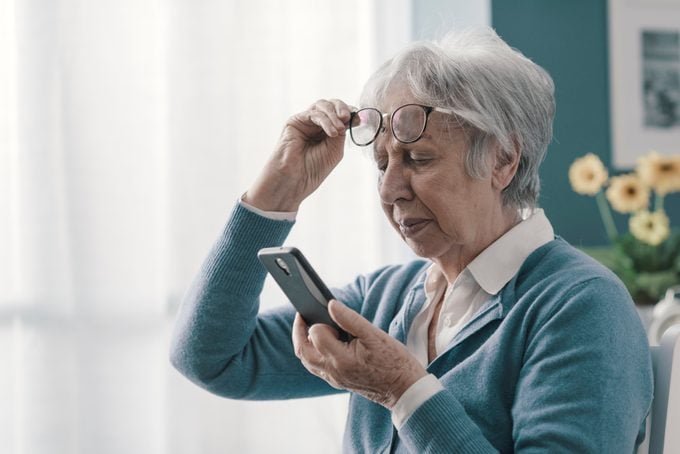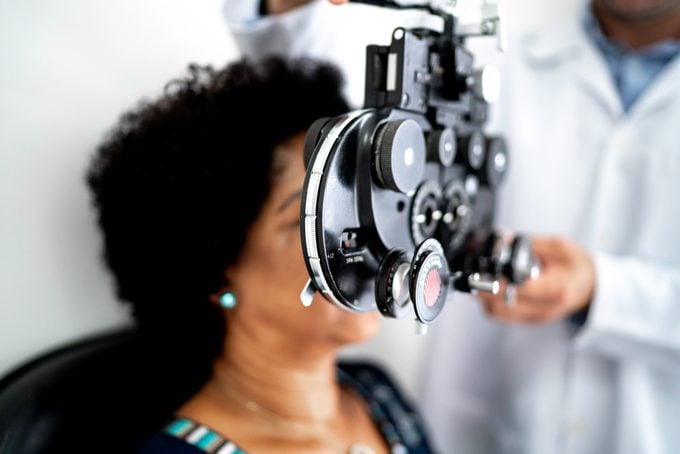What Is Macular Degeneration? What to Know About This Sight-Robbing Eye Condition
Updated: May 05, 2023
Age-related macular degeneration is a leading cause of blindness. Learn how to recognize it before you even have symptoms plus some vitamins that may help.
What is macular degeneration?
Age-related macular degeneration (AMD) is a progressive eye disease primarily affecting your central vision, making it difficult to cook, read, drive, and recognize people. According to David Rein, director of the public health analytics program at NORC at the University of Chicago who authored a study on AMD in 2019, nearly 20 million adults have this condition, and almost 1.5 million people have late-stage AMD.
“It’s a leading cause of blindness in the United States and in the world,” says Emily Y. Chew, MD, the director of the division of epidemiology and clinical applications at the National Eye Institute. “The older you are, the more likely you are to get it.”
Learn about the two types of macular degeneration and how you can recognize the condition in its development stages.
Types of macular degeneration
As many as 90% of people with macular degeneration have what’s called “atrophic macular degeneration,” otherwise known as “dry macular degeneration.”
“Over the course of a lifetime, the byproducts of vision build up underneath the retina and form deposits called drusen,” explains Jacque Duncan, MD, a professor of clinical ophthalmology and academic director of the Retina Service at the University of California San Francisco.
“This leads to thinning of the macula at the center of the retina and loss of cells in that area, eventually leading to vision loss,” says Brian Boxer Wachler, MD, ophthalmologist and Medical reviewer at All About Vision.
Many fewer people have advanced neovascular AMD, also known as “wet AMD,” but they may lose their vision quickly when they do. “[Advanced neovascular AMD] is when new blood vessels grow underneath the retina,” Dr. Duncan says. “It causes swelling and leaking and bleeding.”
This least common form of AMD is responsible for some 90% of severe vision loss from AMD. “The wet form really takes its toll on vision,” says Abdhish R. Bhavsar, MD, a clinical spokesperson for the American Academy of Ophthalmology.
11 Signs Your Eyes Could Be in Danger

Risk factors for macular degeneration
No one knows exactly what causes macular degeneration, but older age and family history are the two main risk factors. Another macular degeneration risk factor is smoking, which doubles your chances of developing the condition. “In every study, the more you smoke, the higher the risk,” Dr. Chew says.
Macular degeneration also shares many risk factors with heart disease. These include high blood pressure and high cholesterol; a diet rich in meat, butter, and other saturated fats; and lack of exercise. Instead, you can choose from these 10 foods that slash your risk of macular degeneration.
“Being Caucasian and overexposure to years of sunlight can contribute to risk as well,” Dr. Boxer Wachler says. “Being female is also a risk factor.”
The Best Contacts for Dry Eyes, According to Doctors
Symptoms of macular degeneration
Macular degeneration is a progressive disorder with three stages—early, middle, and late—that unfold over the years. Typically there are no symptoms in the early stages, and symptoms (like mild blurriness) that may go unnoticed in the intermediate stage.
“In early disease, most people don’t even know they have it for years and years and years,” says Dr. Bhavsar, who is also director of the Retina Center in Minneapolis. “The main change in the advanced form is distortion—crookedness or waviness—in your vision.”
While you may maintain your peripheral (side) vision, you’ll experience blank spots in your central vision and have trouble making out details and seeing in the dark.
Vitamins for dry macular degeneration
There’s no medical treatment for dry AMD, but Luciano V. Del Priore, MD, PhD, chair of the Department of Ophthalmology & Visual Science, Yale had good news in 2023. “The FDA just approved Syfovre, the first drug to treat geographic atrophy, which is an advanced form of dry AMD,” Dr. Del Priore says.
In addition, two large studies sponsored by the National Eye Institute have found that a specific combination of vitamins and minerals can reduce the risk of vision loss by about 25%, Dr. Chew says.
The formula (named AREDS, after the trial) is available over the counter under different brand names, including PreserVision. It won’t help prevent AMD, but it can slow the progression from intermediate to late-stage disease.
“It’s easy to take, and most of the formulations are two pills a day,” Dr. Bhavsar says. “It’s in drugstores and doctors’ offices.”
Make sure the bottle you buy specifically says “AREDS” and contains vitamins C and E, lutein, zeaxanthin, zinc, and copper. An earlier version of AREDS contained beta carotene, but this was found to increase the risk of lung cancer in smokers. Most formulations available today do not contain beta carotene.
The Best Eye Drops for Dry Eyes
Treatments for wet macular degeneration
Unlike dry AMD, wet AMD does have treatments. One is photodynamic therapy (PDT), which uses a combination of an injected medicine and laser light to stunt the abnormal blood vessels.
Anti-VEGF drugs also treat wet AMD by blunting the growth of abnormal blood vessels in your eye. Several of these drugs are available, including Avastin, originally developed for treating colorectal and other forms of cancer.
Screening and diagnosing AMD

The most important thing you can do for the health of aging eyes is to let your doctor check them regularly. The American Academy of Ophthalmology recommends comprehensive eye exams starting at age 40. You may be tempted to only get eye exams if you’re experiencing difficulty reading without corrective lenses—which is common as we age—but you should get your eyes checked regardless.
Not only will these exams, which should include dilation, be able to detect AMD, but they’ll also look for glaucoma and cataracts—two other eye conditions that are more common as we age.
One tool doctors use (and you can also use at home) is an Amsler grid. As its name suggests, it is a grid of horizontal and vertical lines, though you can also use any straight lines as a substitute.
Look at the grid every day using one eye at a time from about a foot away. If any of the lines look dim, wavy, bent, or blurry, contact your doctor. This could signal AMD. “I recommend patients use the grid to help them discover distortion or anything missing in the vision field,” Dr. Bhavsar says.
Preventing AMD
“Pretty much everything that you can think of that can be healthy for your heart turns out to be good for your retina, also,” Dr. Bhavsar says. “This includes a healthy diet, exercise, and healthy cholesterol and blood pressure profile,” Dr. Del Priore adds.
In other words, make sure you get plenty of exercise and eat fruits and vegetables with colors in them (they’re high in antioxidants). Wear sunglasses that block ultraviolet rays (“Even on cloudy days,” Dr. Boxer Wachler adds)…and if you smoke, quit.
- Do You Have an Under-active Thyroid? This 90-Second Quiz Helps You Find Out
- What Is Medical Gaslighting? 9 Doctors’ Statements That Are Major Red Flags
- The 6 Best Sustainable Fish to Eat—and the 7 Worst
- Here’s What Happens to Your Body When You Laugh
Additional writing and reporting by Jaime Stathis.
















